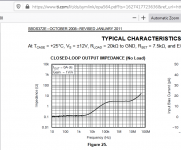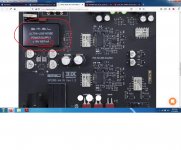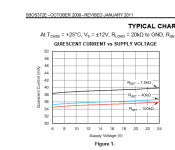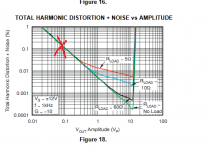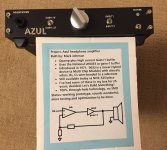This is a tough one, but a very serious inquiry and I am sort of desperate for a solution. I'm wondering if there's any way to lower the output impedance of my SP200 headphone amp, to better match the ridiculous 9 ohm impedance of my beloved Shure SE846 IEM's.
----------------------------------
Some background:
I recently upgraded all the phone amps in my recording studio. after extensive trials with every highly-regarded amp under $600, I settled on the SMSL SP200.
(Not the Massdrop, which I didn't test) It's amazing for the money, and after a psu cap upgrade, which tightens the loose LF, it's staggeringly good.
Unfortunately, I stupidly only tested the amps with studio cans, from 250-600 ohms. I forgot that low impedance IEMs might give different results. My Shure SR846 are about as low as it gets, at only 9 ohms. The SP200 was independently tested as having about a 1.3 ohm output, and yes the mis-match is extremely audible. Harsh, distorted, and a massive loss of LF.
So that's where I'm at. I REALLY don't want to start looking for alternative IEM's, although that may be the only solution.
=============================================
AND SO:
To be clear, I need lower impedance, not (just) lower gain.
I tried an inline resistor network at 80 ohms, but while this brought back the LF and lowered the distortion, it also killed a significant amount of HF. (resistance is not capacitance.) Ugh .....
Maybe a different resistor network design would work better? I know there are L pads, H pads, etc. They all drop the volume, but maybe result in different amounts of HF loss? But probably not, so on to possible amp-mod solutions:
-------------------
I don't have a schematic, so all of this will be tricky even for you guys. For me, it's like a chimp doing quantum physics equations. Well, regardless:
Idea #1: Maybe change the amp's gain structure, by lowering both the input and the output resistance?
Idea #2: Maybe add a little "buffering" circuit on the output. Unity (or even - 6dB) gain but with a super-low output impedance?
Idea #3: Maybe use a different op amp?
The two stock SP200 gain op amps are OPA1612A.
The Benchmarl HPA4, a $3,000 THX-888 design, uses 2 OPA 564 op amps. Surprisingly, (to me) It also uses a pair of OPA1612A dual op-amps as "error-correction" amplifiers.
The HP4A has a rated output impedance of “less than 1 ohm” .
Given my SE846’s 9 ohm impedance, that could actually make a big difference to me.
I’d LOVE to know why Benchmark used this alternate 20-pin power ic, and then used what the SP200 uses as some kind of ancillary circuit. What is “error-correction?”
And the obvious questions:
# Can the OPA 564 be used as a direct-replacement for the SP200’s 1612A? (I suspect not)
# If so, could it possibly have a lower output impedance?
- I’m guessing that this is indeed why Benchmark uses the 564, but then something in that IC requires the “error correction” 1612A’s to be added. In which case, there is of course little hope of a direct-swap.
----------------------------------
Some background:
I recently upgraded all the phone amps in my recording studio. after extensive trials with every highly-regarded amp under $600, I settled on the SMSL SP200.
(Not the Massdrop, which I didn't test) It's amazing for the money, and after a psu cap upgrade, which tightens the loose LF, it's staggeringly good.
Unfortunately, I stupidly only tested the amps with studio cans, from 250-600 ohms. I forgot that low impedance IEMs might give different results. My Shure SR846 are about as low as it gets, at only 9 ohms. The SP200 was independently tested as having about a 1.3 ohm output, and yes the mis-match is extremely audible. Harsh, distorted, and a massive loss of LF.
So that's where I'm at. I REALLY don't want to start looking for alternative IEM's, although that may be the only solution.
=============================================
AND SO:
To be clear, I need lower impedance, not (just) lower gain.
I tried an inline resistor network at 80 ohms, but while this brought back the LF and lowered the distortion, it also killed a significant amount of HF. (resistance is not capacitance.) Ugh .....
Maybe a different resistor network design would work better? I know there are L pads, H pads, etc. They all drop the volume, but maybe result in different amounts of HF loss? But probably not, so on to possible amp-mod solutions:
-------------------
I don't have a schematic, so all of this will be tricky even for you guys. For me, it's like a chimp doing quantum physics equations. Well, regardless:
Idea #1: Maybe change the amp's gain structure, by lowering both the input and the output resistance?
Idea #2: Maybe add a little "buffering" circuit on the output. Unity (or even - 6dB) gain but with a super-low output impedance?
Idea #3: Maybe use a different op amp?
The two stock SP200 gain op amps are OPA1612A.
The Benchmarl HPA4, a $3,000 THX-888 design, uses 2 OPA 564 op amps. Surprisingly, (to me) It also uses a pair of OPA1612A dual op-amps as "error-correction" amplifiers.
The HP4A has a rated output impedance of “less than 1 ohm” .
Given my SE846’s 9 ohm impedance, that could actually make a big difference to me.
I’d LOVE to know why Benchmark used this alternate 20-pin power ic, and then used what the SP200 uses as some kind of ancillary circuit. What is “error-correction?”
And the obvious questions:
# Can the OPA 564 be used as a direct-replacement for the SP200’s 1612A? (I suspect not)
# If so, could it possibly have a lower output impedance?
- I’m guessing that this is indeed why Benchmark uses the 564, but then something in that IC requires the “error correction” 1612A’s to be added. In which case, there is of course little hope of a direct-swap.
Assume I am not looking at a fake website. SMSL SP200 THX AAA-888 Headphone Amp – Apos Audio
On their website, I see the specs of SP200, "Output Impedance: Near 0ohm".
How can you be lower than 0ohm?
On their website, I see the specs of SP200, "Output Impedance: Near 0ohm".
How can you be lower than 0ohm?
https://www.ti.com/lit/ds/symlink/opa564.pdf?ts=1627417723636&ref_url=https%253A%252F%252Fwww.ti.com%252Fproduct%252FOPA564
although the output impedance looks reasonable, below 1 ohm, the power supply doesn't look too good on a 9ohm load!
although the output impedance looks reasonable, below 1 ohm, the power supply doesn't look too good on a 9ohm load!
Attachments
Last edited:
On their website, I see the specs of SP200, "Output Impedance: Near 0ohm".
How can you be lower than 0ohm?
"Near zero" is just marketing hyperbole.
This amp was tested by an imdependant user, who seemed extremely competent.
He measured 1.3 ohms.
The Benchmark THX888, again, is rated at "less than 1 ohm," and I trust Benchmark. Again, they are using a different gain ic, so that might be why.
As a reference, the JDS Atom (which works GREAT with my IEM's, and may sadly have to be a replacement in my personal rig) is rated at 0.1 ohm, and I also trust JDS. The overrated Neve RNHP1 is 0.8 ohm. The lovely O2 designs are around 0.5, IIRC. 1.3 ohms is really high, by today's standards.
--------------------------
Dreamth, What don't you like about the power supply? (this is slightly beyond me, but I'll try to keep up.) Is this one of those "high voltage swing, but not enough current" designs? Can this be improved? Maybe by using an external supply?
Last edited:
Would something like this be a good bet?
Finished Hifi M Power Linear power supply DC18V @2.7A PSU with Protection + display DC PSU|AC/DC Adapters| - AliExpress
2.7a, linear supply. Nice tranny. Not horribly expensive.
Probably needs better caps though, lol......
Of course, I might still have an impedance issue, but maybe this is worth trying on just one of my amps?
Or other suggestions? (I'd prefer something pre-made)
Finished Hifi M Power Linear power supply DC18V @2.7A PSU with Protection + display DC PSU|AC/DC Adapters| - AliExpress
2.7a, linear supply. Nice tranny. Not horribly expensive.
Probably needs better caps though, lol......
Of course, I might still have an impedance issue, but maybe this is worth trying on just one of my amps?
Or other suggestions? (I'd prefer something pre-made)
Update:
I ran my numbers using this calculator:
Headphone Power Calculator - Headphonesty
Using my IEM's sensitivity of ~ 135 DB/V, the 9 ohm rating, and desired loudness of 102 DBSPL (which is crazy loud)
This calculator says I only need the following:
1 mw
0.99v
10.5 ma
Can that possibly be correct?
I ran my numbers using this calculator:
Headphone Power Calculator - Headphonesty
Using my IEM's sensitivity of ~ 135 DB/V, the 9 ohm rating, and desired loudness of 102 DBSPL (which is crazy loud)
This calculator says I only need the following:
1 mw
0.99v
10.5 ma
Can that possibly be correct?
Right you are.
It seems awfully low to me.
Anyway, waiting on some thoughts about the psu.
I don't really know how to compare things. I know that the JDS puts out 1a at 32 ohms, and so theoretically close to 4a at 9 ohms.
- But what would the spec of his power supply actually be?
- How does that relate to the SP200 supply saying 667ma? - At what impedance is that?
And if a psu does NOT have "enough" current for a given IEM, what would that sound like?
It seems awfully low to me.
Anyway, waiting on some thoughts about the psu.
I don't really know how to compare things. I know that the JDS puts out 1a at 32 ohms, and so theoretically close to 4a at 9 ohms.
- But what would the spec of his power supply actually be?
- How does that relate to the SP200 supply saying 667ma? - At what impedance is that?
And if a psu does NOT have "enough" current for a given IEM, what would that sound like?
Last edited:
I have no idea what the quiescent current and output voltage offset for 9 ohm r load is, yet at least 100ma are expected for sure for both channels...but the output impedance is kinda high for such powerful ic...although not very far from TPA6120 capabilities which is 1/3rd of opa power .You should still have like 1...2 meters of cabling anyway with any headphones so the damping factor can't be too great with headphones...
Just saw you're talking about some in-ear fantasticaly expensive and sensitive headphones...not sure why you'd need any power for them according to that calculator so i'd still blame on the power source of those op-amps vs idle current even though they look right, while most headphones amps are configured for at least 32 ohms headphones and an output serie resistor might be already in your smpl circuit allowing for good linearity.
OPA564 is general purpose power amp(valve actuator, motor drive) , so distortions look on the high side at 0.2% which can be very audible with such sensitive headphones, while the overshoot due to capacitive loading of that low pass filter is unpredictable for me.
Just saw you're talking about some in-ear fantasticaly expensive and sensitive headphones...not sure why you'd need any power for them according to that calculator so i'd still blame on the power source of those op-amps vs idle current even though they look right, while most headphones amps are configured for at least 32 ohms headphones and an output serie resistor might be already in your smpl circuit allowing for good linearity.
OPA564 is general purpose power amp(valve actuator, motor drive) , so distortions look on the high side at 0.2% which can be very audible with such sensitive headphones, while the overshoot due to capacitive loading of that low pass filter is unpredictable for me.
Attachments
Last edited:
.... It seems awfully low to me.....
The IEM is probably really a hearing aid transducer. Aids have to run on a 1.4V air-cell (so 0.5Vrms max) AND deliver HIGH levels to a deaf ear. HL >60dB is not too uncommon in the aging population, so "typical speech" has to be delivered near 70dB+60dB or 130dB. (Note how close this comes to 135dB/V and 0.5V= 129dB SPL.)
These IEMs are so highly tuned (resonant) that their impedance varies wildly with frequency and with drive level(!). A series resistor is a poor fit, but may be as good as you can get without major drama.
BTW, the *amplifer* output impedance is not a single number. It may be one thing in the midrange but if it has an output capacitor its Z will soar in the bass, so less bass gets to the speaker. The Z may be low when not clipping but will be something else when pushed to the limit. (A speaker amp with a Damping Factor of 800 will not make much power in 0.01 Ohms.)
Those IEMs might be super sensitive 115dB/mW? In which case it’s not an issue because you will be using hardly any current since voltage is so low. I used 8ohm KZ ZM-5’s (quad driver hybrid balanced armature and dynamic driver) with a SE Class A amp designed for 120ohm headphones and it worked fine.
Interesting.
But regardless, my SE846's sound HORRIBLE with this amp.
(I actually forgot to mention this.)
Massive LF rolloff, distortion, and a slightly nasty - edgy sound overall.
They sound great on several sub - $100 amps. Heck they even sound fine being fed from the line-outs on my Lynx DAC.
-----------------------
Sadly, I can't put a second amp in my personal rack, because it goes on the road, and every ounce matters.
But regardless, my SE846's sound HORRIBLE with this amp.
(I actually forgot to mention this.)
Massive LF rolloff, distortion, and a slightly nasty - edgy sound overall.
They sound great on several sub - $100 amps. Heck they even sound fine being fed from the line-outs on my Lynx DAC.
-----------------------
Sadly, I can't put a second amp in my personal rack, because it goes on the road, and every ounce matters.
That SMSL SpS-200 has impressive specs:
If it is quoted as being able to drive 6W into 16ohm loads (it’s a speaker amplifier as far as I am concerned) output impedance is not your issue.
It has a 130dB SNR and was tested by ASR and highly ranked. I have other SMSL amps so I don’t think it’s output impedance that is the problem.
There may be something wrong with your Sure iems.
I have the SMSL L30 which uses the TPA6120A2 output driver and it can drive anything I throw at it. It’s not as fancy as the SP200 made by same company.
Check your IEM cabling. Is it shorted or broken? Use a DMM and measure the DC resistance across your IEM jack. Is it 9ohms or something close to 1ohm? If so, a shorted cable may cause any amp to sound distorted. Very few amps can drive 0ohm loads. 🙂
Output Power:
6W x 2 (16ohm)
3W x 2 (32ohm)
440mW x 2 (300ohm)
220mW x 2 (600ohm)
If it is quoted as being able to drive 6W into 16ohm loads (it’s a speaker amplifier as far as I am concerned) output impedance is not your issue.
It has a 130dB SNR and was tested by ASR and highly ranked. I have other SMSL amps so I don’t think it’s output impedance that is the problem.
There may be something wrong with your Sure iems.
I have the SMSL L30 which uses the TPA6120A2 output driver and it can drive anything I throw at it. It’s not as fancy as the SP200 made by same company.
Check your IEM cabling. Is it shorted or broken? Use a DMM and measure the DC resistance across your IEM jack. Is it 9ohms or something close to 1ohm? If so, a shorted cable may cause any amp to sound distorted. Very few amps can drive 0ohm loads. 🙂
Last edited:
"output impedance is not your issue. "
- Yes it is. The general rule of thumb, according to most experts, is that you need at least a 8X ratio. My IEM's fall below this, and given that the sound I'm hearing is exactly what is to be expected with a too-low impedance, I fail to understand the logic behind your statement.
"I have other SMSL amps so I don’t think it’s output impedance that is the problem. "
- Completely different design.
"There may be something wrong with your Sure iems. "
- No. (As stated earlier.) They work perfectly with all the other (low impedance) amps I tested.
- Yes it is. The general rule of thumb, according to most experts, is that you need at least a 8X ratio. My IEM's fall below this, and given that the sound I'm hearing is exactly what is to be expected with a too-low impedance, I fail to understand the logic behind your statement.
"I have other SMSL amps so I don’t think it’s output impedance that is the problem. "
- Completely different design.
"There may be something wrong with your Sure iems. "
- No. (As stated earlier.) They work perfectly with all the other (low impedance) amps I tested.
This test says the closed loop output impedance is below 1 Ohm across the audible range of frequencies.
Another independent measurements of SMSL SP200 | Audio Science Review (ASR) Forum
Another independent measurements of SMSL SP200 | Audio Science Review (ASR) Forum
Last edited:
Remove the protection components which prevent amplifier oscillation when some yutz connects 50 foot long headphone cables. This will lower the output impedance.
Get a different headphone amplifier which uses a "composite amplifier" design; namely an opamp and a high current booster, all within a single negative feedback loop. You could use an LT1010 or a BUF634A or (if you are as mentally defective as me), an LH0033 video buffer, or an LME49600, or a class-A push pull discrete power transistor buffer like the WHAMMY headphone amp sold in the diyAudio store.
Now the open loop output impedance is very low, thanks to the current booster, and the closed loop output impedance is EXTREMELY low, thanks to scads of negative feedback around the opamp+booster loop.
Here's a display placard that I drew to explain the basic concept. I put it on the exhibit tables next to my Azul headphone amp, at the 2019 Burning Amp Festival.
_
Get a different headphone amplifier which uses a "composite amplifier" design; namely an opamp and a high current booster, all within a single negative feedback loop. You could use an LT1010 or a BUF634A or (if you are as mentally defective as me), an LH0033 video buffer, or an LME49600, or a class-A push pull discrete power transistor buffer like the WHAMMY headphone amp sold in the diyAudio store.
Now the open loop output impedance is very low, thanks to the current booster, and the closed loop output impedance is EXTREMELY low, thanks to scads of negative feedback around the opamp+booster loop.
Here's a display placard that I drew to explain the basic concept. I put it on the exhibit tables next to my Azul headphone amp, at the 2019 Burning Amp Festival.
_
Attachments
Your SP200 is rated 16 ohm minimum impedance so we are starting with the wrong foot.This is a tough one, but a very serious inquiry and I am sort of desperate for a solution. I'm wondering if there's any way to lower the output impedance of my SP200 headphone amp, to better match the ridiculous 9 ohm impedance of my beloved Shure SE846 IEM's.
Why not use a properly rated amp to drive your earphones?
Ouch!!!Unfortunately, I stupidly only tested the amps with studio cans, from 250-600 ohms. I forgot that low impedance IEMs might give different results. My Shure SR846 are about as low as it gets, at only 9 ohms.
You must have some other problem; if it expects 16 ohm, going to 9 is not optimum but NO WAY it will cause that >>HORRIBLE<< sound you are describing.The SP200 was independently tested as having about a 1.3 ohm output, and yes the mis-match is extremely audible. Harsh, distorted, and a massive loss of LF.
NO WAY
What you describe does NOT match such a small impedance mismatch.To be clear, I need lower impedance, not (just) lower gain.
Harsh, Distorted describes way above10% distortion.
massive loss of LF describes, say, 10dB loss or worse, say, below 200 or 300 Hz.
Not sure about your "80 ohm network" but in any case, it can only be lossy.I tried an inline resistor network at 80 ohms, but while this brought back the LF and lowered the distortion, it also killed a significant amount of HF. (resistance is not capacitance.) Ugh .....
Adding extra attenuation to an already overdriven distorted system can only make things worse.
Maybe a different resistor network design would work better? I know there are L pads, H pads, etc. They all drop the volume, but maybe result in different amounts of HF loss? But probably not, so on to possible amp-mod solutions:
-------------------
I don't have a schematic, so all of this will be tricky even for you guys. For me, it's like a chimp doing quantum physics equations. Well, regardless:
Idea #1: Maybe change the amp's gain structure, by lowering both the input and the output resistance?
Idea #2: Maybe add a little "buffering" circuit on the output. Unity (or even - 6dB) gain but with a super-low output impedance?
Idea #3: Maybe use a different op amp?
The two stock SP200 gain op amps are OPA1612A.
The Benchmarl HPA4, a $3,000 THX-888 design, uses 2 OPA 564 op amps. Surprisingly, (to me) It also uses a pair of OPA1612A dual op-amps as "error-correction" amplifiers.
The HP4A has a rated output impedance of “less than 1 ohm” .
Given my SE846’s 9 ohm impedance, that could actually make a big difference to me.
I’d LOVE to know why Benchmark used this alternate 20-pin power ic, and then used what the SP200 uses as some kind of ancillary circuit. What is “error-correction?”
And the obvious questions:
# Can the OPA 564 be used as a direct-replacement for the SP200’s 1612A? (I suspect not)
# If so, could it possibly have a lower output impedance?
- I’m guessing that this is indeed why Benchmark uses the 564, but then something in that IC requires the “error correction” 1612A’s to be added. In which case, there is of course little hope of a direct-swap.
You need FIRST to diagnose your actual problem.
Absolute minimum test is to inject a 1kHz tone into your SP 200, load it with a 10W 16 ohm resistor and drive it *just* to clipping, then slightly back down.
Measure voltage, show us a screen capture, if you have distortion meter or a spectrum analyzer (many modern scopes have them built in) and show results.
Expand it by repeating at different frequencies.
For MP3 test tones at useful frequencies:
Download Audio Tone Files
100 - 250 - 440 - 1k - 10k Hz.
Use the 30 second ones and set player to "repeat" so you have continuous tone.
This will show us the REAL capabilites of your SP200 into an officially acceptable load.
Then repeat but with a 9 ohm load.
I suspect there will no significant differences, but test it yourself, besides maybe some reduced power, say 4W RMS instead of rated 6W or thereabouts, and still AMPLE to drive those phones.
To check where it really becomes underrated, repeat with, say, 4 ohm, 2 ohm, 1 ohm loads.
Measuring beats guessing any day of the week.
Having solid results will let us suggest real solutions.
And by the way, I do not expect gross distortion or extreme Bass reduction (if at all) while driving 9 ohm, but let real test results speak by themselves, anything else is idle talk.
Has anybody suggested a couple of small output transformers yet? 9:1 or 16:1 would probably be plenty.
It might exact a small sound quality penalty. But it would have the advantage of being a 'point of use' solution -- its own little aluminum box, its own meter or two permanently attached cable to plug in where the other headphones do, then a jack for the Shure IEM's.
Cheers
It might exact a small sound quality penalty. But it would have the advantage of being a 'point of use' solution -- its own little aluminum box, its own meter or two permanently attached cable to plug in where the other headphones do, then a jack for the Shure IEM's.
Cheers
I think the headphone cable or the XO network (4 driver balanced armatures) is defective: internally shorted somewhere. The problem described matches exactly what a shorted cable produces.
I agree with Jfahey. No way would going from 16ohm to 9ohm cause massive distortion.
I agree with Jfahey. No way would going from 16ohm to 9ohm cause massive distortion.
Last edited:
Has anybody suggested a couple of small output transformers yet?...
That's obvious
 , but may not be the way the OP wishes to go.
, but may not be the way the OP wishes to go.- Home
- Amplifiers
- Headphone Systems
- Lower a headphone amp's output impedance?
